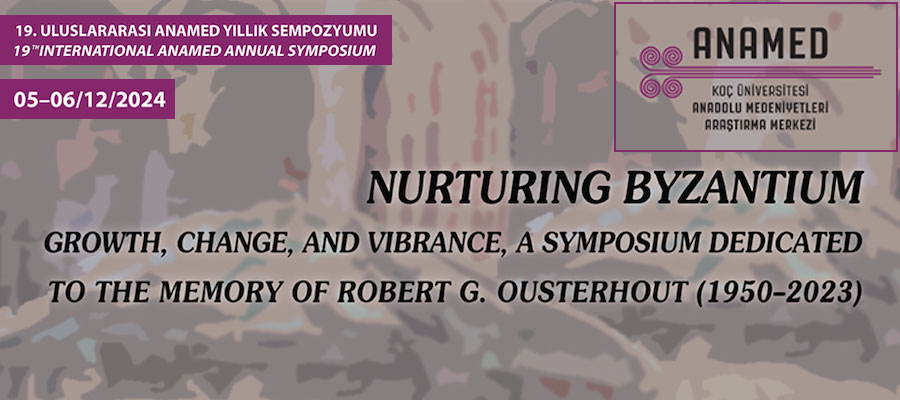Nurturing Byzantium: Growth, Change, and Vibrance in Byzantine Studies, A Symposium Dedicated to the Memory of Robert G. Ousterhout (1950–2023), ANAMED, Koç University and Zoom, December 5–6, 2024
This symposium is a tribute to the memory of Robert G. Ousterhout, a leading figure in Byzantine and Eastern Medieval architectural history, who recently passed away. Known to many as Bob Ousterhout, he was a prolific writer, a scholar, a caring friend, and a mentor. His ground-breaking publications significantly influenced the field of Byzantine studies, integrating written sources, material culture, and the elements of climate, environment, economy, and socio-religious history.
Throughout his life, he kept many research interests alive, which include: the role of the masons in the transmission of architectural knowledge, hieroscapes, analyses of the long metamorphoses of iconic monuments of Byzantium and the Mediterranean—Hagia Sophia, the Chora, the Holy Apostles, the Pantokrator, and the Church of the Holy Sepulchre—and in-depth analyses of the concepts of originality, pseudo-spolia, sacrality, and identity. His architectural readings on Constantinople, Cappadocia, Thrace, and Jerusalem were the defining publications interpreting Byzantine landscapes’ changing functions and fortunes. His wide temporal and geographical lens contributed immensely to our understanding of Byzantine realms and their microcosmic reflections of the changing and dynamic nature of urbanism in the Mediterranean.
Bob Ousterhout’s interdisciplinary approach and his unique blend of architectural history with landscape archaeology, as demonstrated in his work on Cappadocia, set him apart. He often emphasized the distinction between architectural style and technique, as he did when he stated that “architectural forms do not float freely across the regions; they require a human agent to effect the passage.” His focus on routes of architectural forms and connectivities within and beyond Byzantium, particularly his work on the Chora and Cappadocia, and his love for inscriptions, epigrams, and donor portraits provided a textured perspective of the representation of ideology and power. His work on monuments but also on monumental figures who contributed to the emergence and rise of Byzantine studies—ranging from Gertrude Bell to John Henry Haynes, Osman Hamdi Bey, and Thomas Whittemore—the birth of archaeological explorations in Anatolia and the Middle East, and the preservation of the built environment was exemplary.
The symposium will be structured around three themes, each focusing on a different aspect of Bob Ousterhout’s life and legacy. The first (Growth) will feature scholars who worked closely with him during his tenure at the University of Illinois and UPenn. They will provide insights into his personality, his influences, and the contexts that shaped his thinking, research, and fieldwork skills. The second (Change) is Byzantine studies led by Bob Ousterhout. In this, we include scholars who worked with him on various topics and regions while writing dissertations or collaborated with him in multiple fieldwork projects, study trips, or programs he ran. The third (Vibrance) is Byzantine studies beyond Bob Ousterhout. In this theme, we include the scholars whose academic and pastoral paths crossed with Bob and whose work on Constantinople, Cappadocia, Jerusalem, and the larger Byzantine and Islamic realms we see Bob’s legacy in.
With this symposium, we would like to honor Bob’s memory as a nurturer of buildings and sites. He once said in a Cornucopia article that “old buildings are like grandparents” and that “we loved them just as much in their old age,” but they needed periodic check-ups and medicine. Bob loved his buildings and brilliantly showed us how to take care of them by studying and making them academically and publicly known. He tirelessly worked to raise funds, acquire permits to preserve them, and urged us to explore them further and elaborate on or challenge his interpretations. Bob was a passionate and committed spokesperson who always acknowledged the importance of raising the profile of Byzantine studies in Turkey. He tirelessly nurtured his students, colleagues, and friends. His nurturing changed us and how we look at Byzantium, a field that constantly grows, changes, and stays vibrant thanks to his scholarship and personality.
The hybrid symposium organized in collaboration with Dumbarton Oaks and ARIT is open to the public. English and Turkish simultaneous translation will be provided.
Register in advance for Zoom link.
Conveners: Suna Çağaptay, Tolga B. Uyar, and Engin Akyürek
